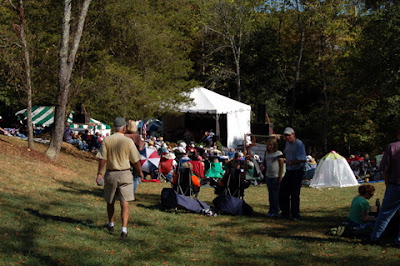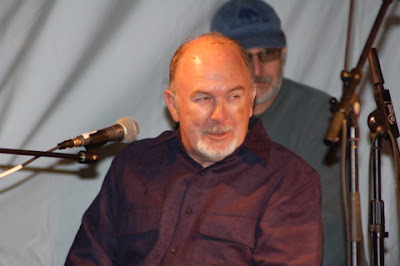
If you’re looking for a bluegrass festival, this isn’t it.
How about an Americana music festival?
Well…no. Mountain music? Not that either.
It’s not folk music either.
But if you’re after just plain great music leavened with the taste and great picking of the
Kruger Brothers,
Carolina in the Fall is the place you want to be on the third weekend in October.
In a sense Carolina in the Fall isn’t a Music Festival as you might think of one.
There aren’t a bunch of bands who come here to perform and then leave.
There’s no easily recognizable schedule, so you won’t be able to return to your rig to jam until the band you want to see takes the stage.
There’s no camping on the Shepherd Farm.
There’s the Kruger Brothers and an eclectic bunch of their friends from the U.S. and Europe.
There are old time mountain people like
Maynard Holbrook, and
Clint Howard, hot pickers like
Scott Fore and
Steve Kilby, singer/songwriters like Charles Tesh and
Si Kahn, family singer/pickers like
Zeb and Samantha Snyder and the
Cockman Family.
Ove

r the day and a half, you’ll hear just about any kind of acoustic…well, there’s electric, too…music you may want.
And overarching all are the glorious sounds and expansive spirits of the Krugers themselves.
There is simply no one who plays a banjo better than Jens Kruger. Uwe Kruger is a marvelous flat picker and rhythm guitarist and a fine singer. Joel Landsburg is incomparable on the bass. One of the three hits a chord and, as if by magic, all three are on the same musical page, playing so well they don’t have to pay attention to their instruments, leaving themselves time and energy to be totally in tune with each other. During their workshop in the morning, Jens, Uwe, and Joel just s at on stage and chatted with the audience about their instruments, strings, learning to play, making a living playing in Europe, practice, scales…the whole world of music. Whenever they wanted to illustrate a point, one would strike a chord and immediately all three were into the middle of the piece with no introduction or discussion at all. Their precision and verve not only gave the audience education in the world of music, but presented models of how people g
at on stage and chatted with the audience about their instruments, strings, learning to play, making a living playing in Europe, practice, scales…the whole world of music. Whenever they wanted to illustrate a point, one would strike a chord and immediately all three were into the middle of the piece with no introduction or discussion at all. Their precision and verve not only gave the audience education in the world of music, but presented models of how people g et to be in tune with each other.
et to be in tune with each other.
Perhaps the most remarkable thing about watching the Krugers work with all sorts of people during the two days was the way their performance always served the music first. It’s not as if they have no ego. Each man in the trio knows how good he is, but ego is subordinated to the music. Each performer invited to Carolina in the Fall brought a particular sound or skill level. A number of children performed. Simple country men, or at least as simple as years of performing at festivals leaves a person, talked and sang. Sophisticated singer/songwriters and world champion flat pickers sat on the stage with men of local renown. In their solo sets, the Krugers played favorites from their albums, improvised on a variety of forms, sang, and talked and joked with the crowd in a relaxed and genuinely welcoming fashion. In every case, the K rugers stayed on stage with them and provided the backup to help make their music sound its very best.
rugers stayed on stage with them and provided the backup to help make their music sound its very best.
A good example of this occurred on Friday night. BackPorch Bluegrass is a very good local band composed of men who play gigs regularly in the region, but who have either by choice or necessity kept their day jobs and continued to play as an avocation and to supplement their incomes. Billy Ray Sunderlin is an accomplished banjo picker, but there are hundreds of men across the country who pick at the same level. Near the completion of their performance kicking off the festival on Friday, the Krugers took the stage to pick with them. Billy Ray indicated his willi ngness to let Jens, the master, take the lead, but Jens kept him forefront. Together they ripped off “Foggy Mountain Breakdown,” that classic Earl Scruggs piece known to nearly everyone through the film “Bonnie and Clyde.” The obvious pride Billy Ray took in playing on stage with Jens was only equaled by Jens’ pleasure at playing with him. While it is always within Jens’ capacity to make another player appear the lesser, he never did anything but play in such a way as to make the person he was on stage with sound better.
ngness to let Jens, the master, take the lead, but Jens kept him forefront. Together they ripped off “Foggy Mountain Breakdown,” that classic Earl Scruggs piece known to nearly everyone through the film “Bonnie and Clyde.” The obvious pride Billy Ray took in playing on stage with Jens was only equaled by Jens’ pleasure at playing with him. While it is always within Jens’ capacity to make another player appear the lesser, he never did anything but play in such a way as to make the person he was on stage with sound better.
Another e xample of Jens’ sheer humanity comes from a more personal place. On Friday afternoon I approached Jens to tell him I had bought a Deering 30th Anniversary banjo and how much I loved it. He said he’d like to see it and play it. On Saturday we lugged it over and early in the morning I pulled it out to show him. His eyes lit up as he looked at it and played a few notes on it. He said, “You’ve got a real professional tool here.” He then indicated the instrument needed some set-up and asked if I would mind if he changed the bridge, put on a new set of strings, and made some other adjustments. I leapt at the offer and he named a general time period later in the day. As the day went along, I decided that the Krugers were surely much too busy for the dreamed tune-up to ever happen and prepared to carry my banjo back to the truck. I was chatting with Uwe Kruger when Jens came up carrying a small tool box and said, “I’m ready.”
xample of Jens’ sheer humanity comes from a more personal place. On Friday afternoon I approached Jens to tell him I had bought a Deering 30th Anniversary banjo and how much I loved it. He said he’d like to see it and play it. On Saturday we lugged it over and early in the morning I pulled it out to show him. His eyes lit up as he looked at it and played a few notes on it. He said, “You’ve got a real professional tool here.” He then indicated the instrument needed some set-up and asked if I would mind if he changed the bridge, put on a new set of strings, and made some other adjustments. I leapt at the offer and he named a general time period later in the day. As the day went along, I decided that the Krugers were surely much too busy for the dreamed tune-up to ever happen and prepared to carry my banjo back to the truck. I was chatting with Uwe Kruger when Jens came up carrying a small tool box and said, “I’m ready.”
We went into the musicians tent behind the stage and Jens took the resonator off my instrument, played a few notes and started replaced the bridge with a new Snuffy Smith. He then put on a new set of d’Addario strings and filed the bridge and the nut as well as adjusted the tension rods and the head tension. When he sighted down the neck, I was a little worried, but he seemed happy. Every once in a while he’d play a few notes before making slight adjus tments to the head tension. His movements were sure and quick, but never hurried. Before he replaced the resonator, I asked him to sign it on the inside, where he wrote “Alles sind Gutt,” and signed and dated it. He then played both his patented triplet laden runs up and down the neck as well as a bluegrass break, bending the neck to provide his particular touch. He had deepened the tone, increased the sustain, and brightened the high end all at once. He nodded, smiled and looking at Steve Kilby, the great flat picker from Wilkesboro, and said, “It sounds better than mine.” Talk about swell with pride! On Sunday afternoon I finally got a chance to play it myself. Guess what. I still don’t sound like Jens Kruger, but the instrument has a deeper and more resonant sound and is even more responsive than before. And I’ve had another priceless gift from the world we’ve only discovered in the past five years. Thanks, Jens.
tments to the head tension. His movements were sure and quick, but never hurried. Before he replaced the resonator, I asked him to sign it on the inside, where he wrote “Alles sind Gutt,” and signed and dated it. He then played both his patented triplet laden runs up and down the neck as well as a bluegrass break, bending the neck to provide his particular touch. He had deepened the tone, increased the sustain, and brightened the high end all at once. He nodded, smiled and looking at Steve Kilby, the great flat picker from Wilkesboro, and said, “It sounds better than mine.” Talk about swell with pride! On Sunday afternoon I finally got a chance to play it myself. Guess what. I still don’t sound like Jens Kruger, but the instrument has a deeper and more resonant sound and is even more responsive than before. And I’ve had another priceless gift from the world we’ve only discovered in the past five years. Thanks, Jens.

Robert and Brenda Shepherd have shaped a marvelous experience for music lovers on their lovely farm located at 579 Armory Road in North Wilkesboro, NC. They say the festival developed out of their outgrowing the basement of their home where folks used to stop in to listen to and pick with the Krugers. They’ve provided an intimate two day event, which they want to remain small and informal. I guess, rather than call Carolina in the Fall a festival, I’d characterize it as a celebration – a celebration of music in almost any format, but most of all of the Kruger Brothers and the contributions they make to bringing together diverse strands into a magnificent unity.
Robert, Brenda, and Monica Shepherd

Carolina in the Fall is held in North Wilkesboro, NC on the third weekend in October each year.
Visit their
website for more information.
Rather than write detailed analyses of the many player at this event, I’ll put up more pictures.
Andy Owens
Fiddle Jam
 Steve Kilby
Steve Kilby

Charles Tesh
 Maynard Holbrook
Maynard Holbrook
 Amazing Grace
Amazing Grace






















































